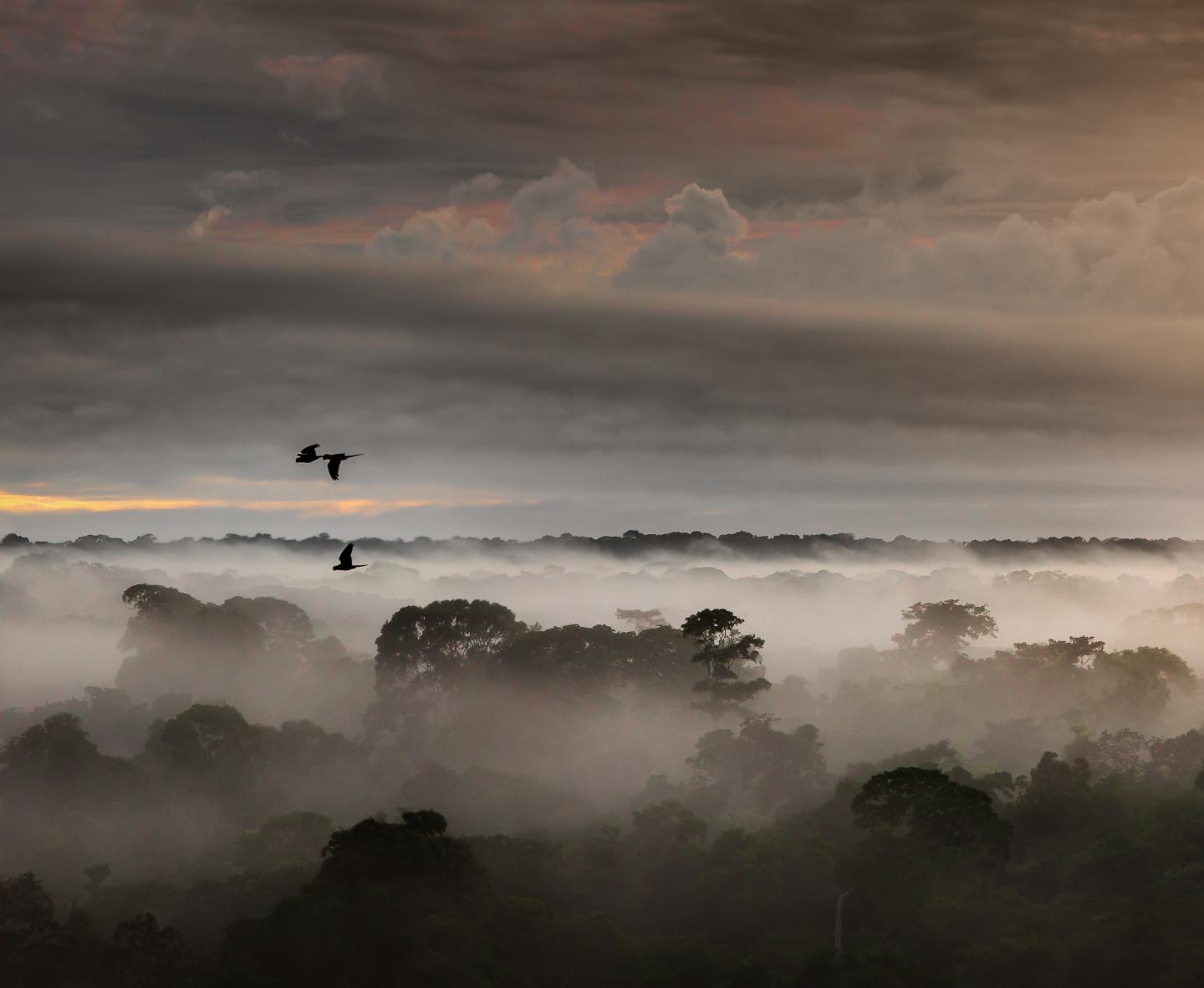

Macaws flying over the rainforest canopy at dawn. The study found that bird lineages that inhabit the forest canopy, such as these macaws, accumulate fewer species over evolutionary time than do bird lineages that inhabit the forest understory.
Credit: Image courtesy of Mike Hankey.
Birds that are related, such as Darwin's finches, but that vary in beak size and behavior specially evolved to their habitat are examples of a process called speciation. It has long been thought that dramatic changes in a landscape like the formation of the Andes Mountain range or the Amazon River is the main driver that initiates species to diverge.
However, a recent study shows that speciation occurred much later than these dramatic geographical changes. Researchers from LSU's Museum of Natural Science have found that time and a species' ability to move play greater parts in the process of speciation. This research was published today in the print edition of Nature.
“The extraordinary diversity of birds in South America is usually attributed to big changes in the landscape over geological time, but our study suggests that prolonged periods of landscape stability are more important,” said Robb Brumfield, LSU Museum of Natural Science director and Roy Paul Daniels professor in the Department of Biological Sciences, one of the lead authors.
Brumfield and his colleagues examined the genealogy of 27 species of birds in the most bio-diverse region in the world, the Neotropics, which extends from southern Mexico through Central America to southern Brazil and includes the Amazon rainforest.
“By using detailed sampling of many bird lineages, we were able to get a clearer and larger picture of when and how species formed within those lineages,” Brumfield said.
The genetic data showed multiple accounts of species divergence, from nine to 29 different instances across the Andes Mountains that varied over time. This shows that rather than being the primary cause of speciation, the formation of the Andes Mountains had an indirect effect on diversification as a semi-permeable barrier.
The researchers then investigated how the history and ecology affected speciation among the 27 lineages of birds. They discovered the longer length of time a species can inhabit an area, the more likely it will disperse and diverge. Also, the less mobility a species has, the more likely it will diverge as well.
For example, birds restricted to the forest floor showed significantly higher species diversity than birds that inhabited the forest's open canopy. These findings have conservation ramifications. If a species cannot inhabit the same area for an extended time, it will not have the opportunity to evolve and continue.
“Our results suggest that human alterations of the landscape can effectively kill the speciation process,” Brumfield said.
This research was funded by the National Science Foundation. Other institutions involved in this research include the American Museum of Natural History, City College of New York, Museu Paraense Emílio Goeldi in Brazil, Universidad de los Andes in Colombia, Universidad Central de Venezuela, Colección Ornithológica Phelps, University of California Los Angeles and the University of Georgia Athens.
The thousands of samples used in this study represent the culmination of more than 30 years of field expeditions led by generations of LSU students and scientists, plus similar work done by ornithologists at other research institutions.
The mission of the LSU Museum of Natural Science is the acquisition, preservation and study of research collections by museum faculty, staff and students to generate knowledge of regional and global biodiversity, geological history and human history/prehistory for the benefit of the people of Louisiana, the nation and the world. For more information on the museum, visit http://www.museum.lsu.edu/
Follow the museum's Twitter, @LSU_MNS. Like the museum's LSU Big Day Peru Facebook for updates as the international award-winning birding team prepares to break the world Big Day record, http://www.facebook.com/LSUBigDay
The mission of the Department of Biological Sciences is to create and disseminate new knowledge in the biological sciences through research; to provide for its majors the highest quality, nationally recognized, graduate and undergraduate educational programs; to provide exceptional science training to support the university's general education requirements; and to contribute expertise in support of science education in the community, including the use of available resources to improve K-12 science outreach. For more information, visit http://www.biology.lsu.edu/












